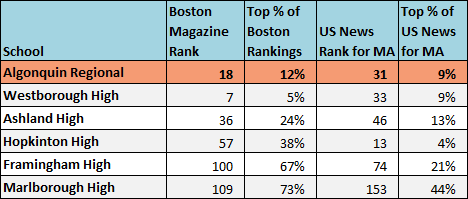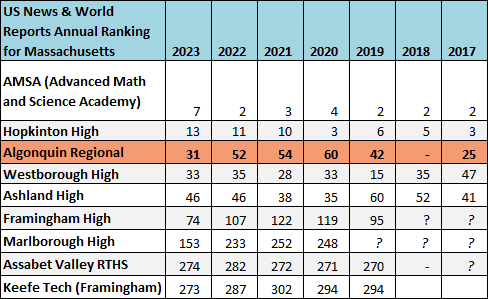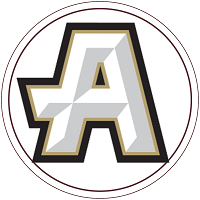Two magazines posted their updated rankings for best public high schools last week. Algonquin Regional fared well this year — though not as well as it initially appeared in one of the magazines.
Here’s my look at how Algonquin, Assabet, and neighboring high schools compared in this year rankings (and over time), plus why the rankings were so different.
The highlights were US News & World Reports’ ranking Algonquin #31 in Massachusetts, in the top 10% for the state. The magazine also ranked ARHS #111 in the nation for STEM schools (math and science education), making them #17 in the state.
The school didn’t do quite as well in Boston Magazine’s rankings of schools in “Greater Boston”. Yet readers might find the metrics that magazine used weak compared to the US News method. (Scroll down for details on the Methodology each magazine used.)
At first glance, Boston Magazine’s “Honorable Mention” list for schools appears to give Algonquin a #1 ranking.* But it turns out, the school is just among the top schools selected for that category. A footnote specifies that the 11 schools are listed “alphabetically”! (Still, that puts the school in the top 7%.)
Of the 5 neighboring towns that were included in both rankings, only one was ranked higher by US News than Algonquin — Hopkinton High. They came in at #13 for the region. In contrast, Boston Magazine ranked ranked them almost 40 notches lower than Algonquin. Meanwhile, Boston ranked Westborough higher than Algonquin while US News ranked it lower.
Below is a chart for how Algonquin fared in both rankings:

I didn’t include above schools that weren’t ranked by Boston Magazine. Below are US News rankings since 2017 that also include the vocational school for Southborough (Assabet) and a neighbor (Keefe Tech), plus the always well ranked charter school next door (AMSA). Over the years, ARHS rankings have widely fluctuated. That has partially been based on the magazine making adjustments to its ranking methodologies.

[Note: When I couldn’t find the data, I inserted “?”. However the dashes for ARHS and AVRTHS in 2018 reflect that the magazine chose not to rank those schools that year.]
It’s worth noting that the methodologies are clearly geared for determining which schools are best for students to get into a selective college. That means vocational schools (which US News doesn’t give a special category for) rank poorly in comparison. (Yes, many students go on to college from a vocational school. But a higher percent of students that aren’t interested in academics and don’t take AP tests and will naturally attend a school that helps them directly prepare for the workforce.)
2023 Methodologies:
Both magazines used data from the Mass Dept of Secondary Education’s website. (You can see Algonquin’s DESE Report Card here.) But they chose different metrics and weightings.
Based on their methodology description, Boston Magazine relied on MCAS scores (% scoring proficient or higher), average class size, and student-to-teacher ratio (with lower considered to be better for the last two categories).**
Boston posted Honor Rolls for the top 10 schools with “Exemplary Teacher Ratings”. ARHS wasn’t on the list. I was curious about our ratings for the category, so I looked it up on DESE’s website and discovered that 0% of ARHS teachers were ranked Exemplary. That has been the case for the past several years.
The ratings are based on teacher evaluations performed by the district and the % can vary widely. So, I checked with Superintendent Gregory Martineau for context on why ARHS doesn’t rate any of its teachers “Exemplary”. He responded:
As a District, it was decided about ten years ago not to award educators the exemplary rating. The practice has remained; however, it is being revisited this fall for the upcoming evaluation cycle.
As for the magazine’s “Bank for the Housing Buck” list, that was based on “institutions whose high school rankings most significantly surpassed the ranking of their respective median home price”. You can read their full rankings and methodology description here.
US News methodologies were much more complex – encompassing MCAS proficiency along with graduation rates, and information on AP Exams (including % of students that took/passed at least one and % that took/passed multiple exams). They also looked at how well black, Hispanic, and low-income students fared on MCAS. Although they listed student teacher ratios, they aren’t referred to as a factor in the rankings. You can read their full explanation here. You can read their full report on Algonquin here.
*An email from the NSBORO district to the community incorrectly touts Algonquin as ranked #1 for the Housing Buck. It appears they missed the magazine’s footnote.
**Boston Magazine’s comparisons weren’t always direct even with the metrics they chose, since the magazine explained that in some cases where the Mass DESE 2022 Report Card data was missing a prior year was used or “a value equal to the weighted average of a school’s other categories”.


